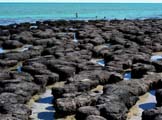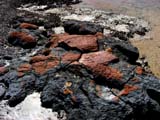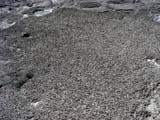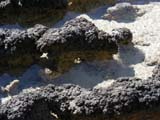|
In June 1954, a group of geologists discovered the stromatolites
or 'living rocks' of Hamelin Pool which linked life on Earth
today, with life on Earth 3.5 billion years ago.
Scientists who have studied fossils of stromatolites, once
believed them to have been wiped out by intense competition
with newer life forms like plants and animals.
While competition dramatically reduced stromatolites worldwide
550 million years ago, Hamelin Pool has provided a safe haven
for stromatolite colonies for the past 5'000 years.
What are Stromatolites?

Stromatolites are layered limestone rock built by single-celled
cyanobacteria (blue-green bacteria) which trap and bind sediments.
Some build craggy towers, others build flat spongy mats.
Stromatolites grow along the shore, usually right up to
the highest tide mark.
They are fragile and can be easily damaged if you touch or
walk on them.

At the entrance to Hamelin Pool is a massive sand bar called
the Fauré Sill, which has built up over 6'000 years
and restricted the tide flow into the Pool.
The shallow waters of Hamelin Pool evaporate quickly and
create super-salty water.
In such harsh conditions, few sea snails can survive to graze
on cyanobacteria.
Hamelin Pool has become a safe neighbourhood for cyanobacteria
which build stromatolites of various shapes and sizes at
different water depths.
In the Beginning stromatolites first appeared in a warm,
salty sea like this.
Bacteria built our stromatolite empire which dominated the
Earth for more than 2 billion years.
Without the oxygen they produced, life on land may not have
evolved.

These red capped stromatolites stopped growing about 500
to 1'000 years ago when the sea level fell.
The reason for their colouring is a mystery.
One guess is it may have been iron in the water as they grew
or the pigment of visiting bacteria.

All Stromatolite are built by cyanobacteria.
Those closer
to shore tend to be flat and spongey while others
in deeper water tend to build up layers to form rocky towers.

Stromatolite layers grow outwards, like the growth rings
of a tree.
Their outer layer remains a thin strip of active
life with a sticky film to trap and bind drifting shells
and sand.
They slowly build up layers which harden into rock.
Scientists believe that their internal growth rings provide
information on local environmental changes during their lifetimes.
Some scientists say that the growth rings in their ancient
relatives reflect changes in the length of days, angle of
the sun, even the rate at which the earth rotated.
Like humans, stromatolites come in various shapes and sizes.
Tidal movement, waves and the abrasive action swirling sand
and shell help to shape them.
The club-shaped stromatolites prefer a deeper water
habitat.
|




